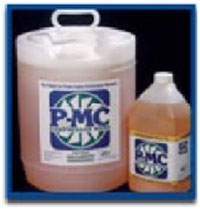P.M.C. Performance Motor Cleaner
The Performance Motor Cleaning System (PMCS) is a system, which intends to remove the deposits that gradually build up in the internal combustion engines. It maintains therefore of the engine at a condition close to the performance of the delivery trials.

The engine fouling consists of deposits of carbon, sulfur, Silica, metals, salts and airborne dust. They are common in all types of engines and are found in scavenge space, cylinders, engine exhaust manifolds and all engine parts moving and stationary in these areas such as air coolers, turbocharger rotors, pistons valves etc.

This situation results in a lower thermal efficiency of the engine, which gets worse day by day. This fact leads to a greater specific consumption of fuel, increased thermal and mechanical load of the engine parts, which creates sooner or later higher costs for spare parts, higher consumption of lubricating oils, reduction of the service speed of the ship because of high temperatures, often damages more or less serious and the need for frequent and expensive cleanings. The use of the PMC system allows the impressive amelioration of the engine parameters and a substantial decrease of the maintenance costs direct or indirect.
We must also mention that by using the PMCS we can avoid cleaning the AIR COOLERS, we can increase the service hours of the TURBOCHARGERS before the overhauling, we can overhaul the cylinders at longer time intervals, etc.
As a method of in service cleaning and maintenance, PMCS is unique for the following reasons:
- It is totally safe, when used, as it is neither toxic nor flammable.
- It does not affect the fuels, the L Oils, or the parts of the engine irrespective of the quantity used.
- It has cleaning effect on all the engine parts, starting from the air intake till the engine exhaust and so it covers all the parts of the engine subject to fouling.
- The injection of the fluid can be made while the engine is running at voyage speed therefore no loss of performance is involved.
- The installation of the system is simple and takes little time. The preparation of the injection requires only a few minutes, and be done easily and with minimum supervision. Most of the times two injection cycles per week that take half an hour or less are required.
- The injection fluid is delivered ready for used and needs no dilution.
- PMCS is the only system to clean the engine while it is running.
HOW AND WHY DOES THE SYSTEM BRING RESULTS
The fluid PMC (PERFORMANCE MOTOR CLEANER) contains active elements that act on the surface of the deposits and that every one of them affects a type of fouling. The fluid, when sprayed covers the deposits instantly and breaks the links holding the different elements of the deposits together. These are a combination of carbon, sulfur, salts, oxides etc. and are deposited in layers. It is obvious that the safest way to remove these deposits is in the same way that they are created, which means PMC has been designed exactly for that purpose, the gradual removal of these deposits in a way of a light dust following the gases of the engine and discharged along with the exhaust gases.

As the deposits are gradually removed we finally reach the metallic surface of the parts of the engine. Then the special corrosion inhibiting ingredients of the fluid R-MC cover the surface and create a thin film that protects the material from corrosion and does not allow new deposits to be created at the same time. As a result PMC does not only clean the engine, but also protects it.
Some ask how is it possible that the PMC remains effective in the combustion spaceand afterwards, because of their high temperatures. The answer is that water, specially treated to remove the harmful elements, is the carrier of the PMC’s ingredients. Water is inflammable, as well as the active ingredients of the PMC. That way, PMC is active even in the warmest are as of the engine. Chemically, it is particularly difficult to use water as a carrier. However, in the case of PMC that was successfully achieved.
This fact, in addition to all above makes PMC a unique as well as safe system.
